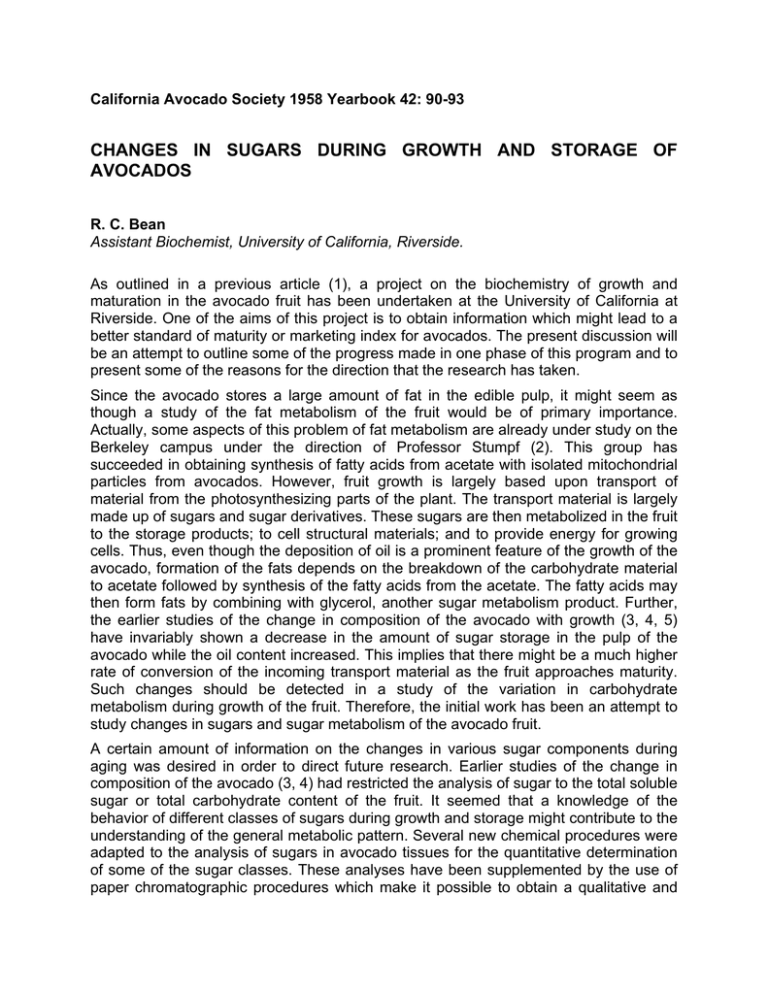CHANGES IN SUGARS DURING GROWTH AND STORAGE OF AVOCADOS
advertisement

California Avocado Society 1958 Yearbook 42: 90-93 CHANGES IN SUGARS DURING GROWTH AND STORAGE OF AVOCADOS R. C. Bean Assistant Biochemist, University of California, Riverside. As outlined in a previous article (1), a project on the biochemistry of growth and maturation in the avocado fruit has been undertaken at the University of California at Riverside. One of the aims of this project is to obtain information which might lead to a better standard of maturity or marketing index for avocados. The present discussion will be an attempt to outline some of the progress made in one phase of this program and to present some of the reasons for the direction that the research has taken. Since the avocado stores a large amount of fat in the edible pulp, it might seem as though a study of the fat metabolism of the fruit would be of primary importance. Actually, some aspects of this problem of fat metabolism are already under study on the Berkeley campus under the direction of Professor Stumpf (2). This group has succeeded in obtaining synthesis of fatty acids from acetate with isolated mitochondrial particles from avocados. However, fruit growth is largely based upon transport of material from the photosynthesizing parts of the plant. The transport material is largely made up of sugars and sugar derivatives. These sugars are then metabolized in the fruit to the storage products; to cell structural materials; and to provide energy for growing cells. Thus, even though the deposition of oil is a prominent feature of the growth of the avocado, formation of the fats depends on the breakdown of the carbohydrate material to acetate followed by synthesis of the fatty acids from the acetate. The fatty acids may then form fats by combining with glycerol, another sugar metabolism product. Further, the earlier studies of the change in composition of the avocado with growth (3, 4, 5) have invariably shown a decrease in the amount of sugar storage in the pulp of the avocado while the oil content increased. This implies that there might be a much higher rate of conversion of the incoming transport material as the fruit approaches maturity. Such changes should be detected in a study of the variation in carbohydrate metabolism during growth of the fruit. Therefore, the initial work has been an attempt to study changes in sugars and sugar metabolism of the avocado fruit. A certain amount of information on the changes in various sugar components during aging was desired in order to direct future research. Earlier studies of the change in composition of the avocado (3, 4) had restricted the analysis of sugar to the total soluble sugar or total carbohydrate content of the fruit. It seemed that a knowledge of the behavior of different classes of sugars during growth and storage might contribute to the understanding of the general metabolic pattern. Several new chemical procedures were adapted to the analysis of sugars in avocado tissues for the quantitative determination of some of the sugar classes. These analyses have been supplemented by the use of paper chromatographic procedures which make it possible to obtain a qualitative and semiquantitative analysis of all the sugars and sugar alcohols. This chromatographic analysis is being adapted, at present, so that accurate quantitative results may be obtained with all sugars. This is especially important in the avocado since it may contain as many as twenty different sugars and sugar alcohols in the free state at certain times. Fluctuations in individual sugars may be quite pronounced and give an indication of specific reactions involved in the production or utilization of the sugar. The data below give some of the results of these phases of the experimental work. Two varieties of avocado were analyzed for sugars through a growing season to find out what variations might be expected. The fruit were picked from trees in the variety orchard at the Citrus Experiment Station in Riverside. One tree was a seedling of the Mexican type and the other was of the Zutano variety. The sugar analyses were carried out immediately upon picking and, later in the season, after a period of storage as well. The chemical analyses made were for the determination of total sugars (5) and for keto sugars (6) and for sucrose (or cane sugar) by the analysis of the residual keto sugar after destruction of free ketose with alkali (7). Analyses were made for these classes of sugars in alcoholic extracts of the peel, pulp and seed. Table I gives a summary of the results found for the changes in sugars of the pulp of the Zutano and Mexican Seedling avocados. Analyses were discontinued when the fruit were harvested at the time when the fat content reached the marketing limit. The chromatographic analyses which were done on these samples to supplement the chemical analyses indicated that the major free sugars in the fresh fruits were glucose, fructose, mannoheptulose and sucrose. In addition, the sugar alcohol, perseitol was present in substantial amounts in all the fresh fruit. Other sugars (e.g., xylose) and sugar alcohols (mannitol or sorbitol) were also found in trace amounts. The analyses for keto sugars in the fresh fruit would reflect the sum of the free fructose, mannoheptulose, and the bound fructose in sucrose. Total sugars would measure, in addition, the free glucose and the bound glucose of sucrose. Perseitol was not measured in any of these analyses but the paper chromatographic procedures made it possible to make a semiquantitative estimate of the amount present at any stage. The figures of Table I show quite parallel behavior in the sugar variations in both types of fruit used. Both show rather high amounts of sugars in the early stages of growth but there is a comparatively abrupt change in the sugar content toward the end of the growing stage. In both fruit, the total sugars dropped from 32 or 35 mg per gram to 12 or 16 mg per gram during the period of a month in September and October. This period corresponded, in the case of the Mexican seedling, to the period of maturation. The samples collected in October were of fairly good quality upon ripening. The Zutano fruit would not ripen properly until six weeks later. Thus, it would appear that the rapid change in sugars was not in direct correlation with preparing for ripening but may have been associated with climatic factors. During the storage periods, there was a large drop in the sugar contents of the two varieties. Usually, the keto sugars showed the highest proportion of losses. In most cases, the remaining free ketose is quite negligible when the bound fructose in the remaining sucrose is taken into account. Sucrose diminished but, relatively speaking, it suffered little loss and could not contribute greatly to the energy metabolism of the fruit. The chromatographic analyses also bore out the conclusion that the ketoses were utilized preferentially during ripening. The mannoheptulose and fructose practically disappeared in all samples leaving glucose and sucrose as the major constituents after ripening or storage. The chromatographs showed other results, as well. Perseitol was also used very rapidly so that it formed only a small part of the neutral fraction after storage although it had been one of the strongest components in the fresh fruit. In addition, a number of new components became fairly prominent. The sugar alcohol mannitol (which was present as a minor constituent in the fresh fruit) became quite pronounced in many cases. Several pentoses, xylose, arabinose and ribose, became apparent and a disaccharide containing xylose was formed. This formation of pentoses must be due to the hydrolysis of polysaccharide material without complete utilization of the sugars formed as the hydrolysis occurs. The formation of ribose was unexpected since it does not normally appear in polysaccharide material or in the free form but it is possible that some of the nucleotidic material (coenzymes, nucleic acids) might be undergoing hydrolysis under storage conditions in the avocado. Another component which appeared in substantial quantities in the stored, mature fruit was glycerol. At the present time, it is not known whether the formation of this alcohol might be due to hydrolysis of fats without utilization of the glycerol, or to formation of glycerol from other sugars. Detailed data on the analyses of the skin and the seed, carried out at the same time as the analyses in Table I, will not be included here. A short summary of the results may be sufficient for purposes of comparison. These studies showed that the behavior of sugars in the skin was quite analogous to that in the edible pulp. Total sugars were quite similar, keto sugars and sucrose were a little higher, generally. The rate of disappearance of these sugars almost paralleled the utilization in the flesh. The abnormal sugars were similar in both the flesh and skin. The seed depends, to a great extent, on starch metabolism during the storage period rather than on the use of the free sugars. Initially, the free sugars of the seed were considerably lower in concentration than in the skin and flesh but after storage there was very little change in the free sugars. One exception to this rule appeared to be perseitol. This sugar alcohol, which is present in large quantities in the seed, frequently was diminished to about one quarter of its initial value during storage. The investigation outlined above has given a certain amount of information on the metabolism of the avocado which was not available previously. It has been done in conjunction with a continuing series of experiments relating such changes in sugar concentrations with the utilization of carbon 14 labeled sugars. Another important study being carried out at the same time is an attempt to find out how the cell wall polysaccharides vary in composition and structure during growth and ripening and determine the activity of enzymes affecting these structural materials under varying conditions. Extensions, refinements and correlations of these analyses may eventually lead into a better knowledge of how fruit grow and ripen. This knowledge will be essential for bringing out any future improvements in marketing standards. I would like to express my appreciation for the technical assistance of Mr. Joseph Metcalf in carrying out the work presented above. LITERATURE CITED 1. 2. 3. 4. 5. 6. 7. Bean, R. C. Biochemical Reactions of Avocados in Relation to Standards of Maturity. Calif. Avocado Soc. Yearbook, 40: 148-151. 1956. Stumpf, P. K. Personal communication, article in press. Church, C. G., and Chace, E. M. Some Changes in the Composition of California Avocados During Growth. U.S. Dept. Agr. Bull. 1073: 1-22. 1922. Stahl, Arthur L. Changes in Composition of Florida Avocados in Relation to Maturity. U. of Fla., Agr. Exp. Sta., Bull. 259: 1-61. 1933. Dubois, M., Gillies, K. A., Hamilton, J. K., Rebers, P. A., and Smith, Fred. Colorimetric Method for Determination of Sugars. Anal. Chem., 28: 350-356. 1956. Dische, Z., and Borenfreund, E. A New Spectrophotometric Method for the Detection and Determination of Keto Sugars and Trioses. J. Biol. Chem., 192:583585. 1951. Bean, R. C., and Hassid, W. Z. Synthesis of Disaccharides with Pea Preparations. J. Am. Chem. Soc., 77: 5737-8. 1956.



